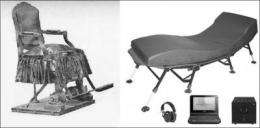19th century therapy for Parkinson's disease may help patients today

In the 19th century, the celebrated neurologist, Jean-Martin Charcot, developed a "vibration chair" to relieve symptoms of Parkinson's disease. He reported improvements in his patients, but he died shortly thereafter and a more complete evaluation of the therapy was never conducted. Now a group of scientists at Rush University Medical Center have replicated his work, and they report that while vibration therapy does significantly improve some symptoms of Parkinson's disease, the effect is due to placebo or other nonspecific factors, and not the vibration. Their study is published in the April issue of Journal of Parkinson's Disease.
"We attempted to mimic Charcot's protocol with modern equipment in order to confirm or refute an historical observation," explains lead investigator Christopher G. Goetz, MD, director of the Rush University Medical Center Parkinson's disease and movement disorders program. "Both the treated group and the control group improved similarly, suggesting other factors had an effect on Parkinson's disease motor function."
Charcot's patients told him that during long carriage rides or train journeys, uncomfortable or painful symptoms of Parkinson's disease seemed to disappear, and the relief lasted quite some time after the journey. He developed a chair that mimicked the continuous jerking of a carriage or train. In their current study, Dr. Goetz and his colleagues randomly assigned 23 patients to either a vibrating chair or the same chair without vibration. During the treatment sessions, both groups listened to a relaxation CD of nature sounds. They underwent daily treatment for a month.
The patients in the vibration treatment group showed significant improvement in motor function after daily 30-minute treatments for four weeks. Although not as high, motor function scores for the no vibration group also improved significantly. Both groups showed similar and significant improvement in depression, anxiety, fatigue, and nighttime sleep and both groups reported similar high satisfaction with their treatment.
"Our results confirm Charcot's observation of improvement in Parkinson's disease symptomology with chronic vibration treatment, but we did not find the effect specific to vibration," Dr. Goetz says. "Instead, our data suggest that auditory sensory stimulation with relaxation in a lounge chair or simply the participation in a research protocol has equivalent benefit as vibration on motor function."
Dr. Goetz concludes, "While we can agree that our results may not change scientific thinking on treatment mechanisms, our results will allow clinicians to guide patients to at least one apparatus that is safe and associated with objective changes in parkinsonian impairment scores. Charcot's advice to colleagues resonates as one places vibration therapy in the context of potential options for patients. 'It is no small gain to be able to relieve the sufferers of paralysis agitans.'"
More information: Journal of Parkinson’s Disease, 2(2012) 23-27. DOI: 10.3233/JPD-2012-12079















